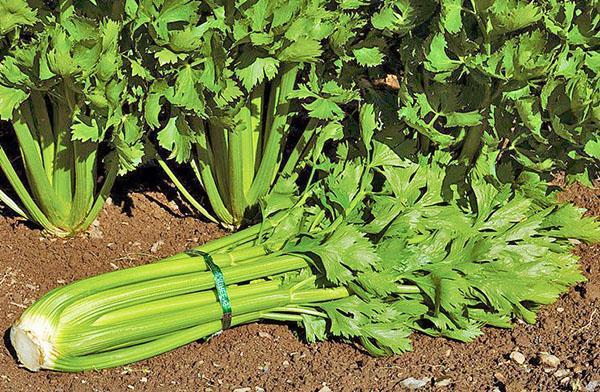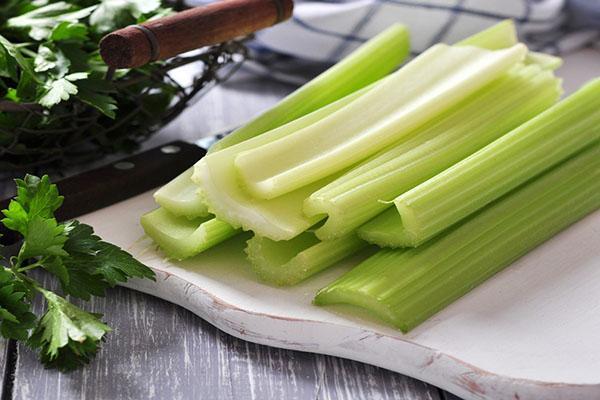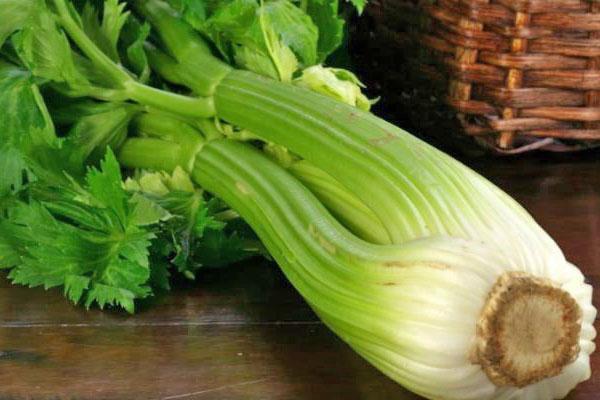Growing and caring for stalked celery is a philosophy of a healthy lifestyle
 Doctors and nutritionists have recognized that growing and caring for stalked celery is worthy of the attention of every family. The beneficial properties of the aromatic plant are widely used in cooking and medicine. Regular consumption of succulent stems / greens promotes the production of essential antibodies in the body. They, in turn, fight infections, viruses, bacteria, and most importantly, cancer cells.
Doctors and nutritionists have recognized that growing and caring for stalked celery is worthy of the attention of every family. The beneficial properties of the aromatic plant are widely used in cooking and medicine. Regular consumption of succulent stems / greens promotes the production of essential antibodies in the body. They, in turn, fight infections, viruses, bacteria, and most importantly, cancer cells.

Painstaking cultivation and care of stalked celery
 The closest "relatives" of pharmaceutical dill are considered to be anise, coriander, carrots, and also cumin. The culture belongs to the umbrella family and is two years old. During the first year, it forms a powerful rhizome along with dense stems. In the second year of the life cycle, umbrella blossoms and fruits appear. All gardeners practice growing this spice in only one season to get pinnately dissected greens and juicy petioles.
The closest "relatives" of pharmaceutical dill are considered to be anise, coriander, carrots, and also cumin. The culture belongs to the umbrella family and is two years old. During the first year, it forms a powerful rhizome along with dense stems. In the second year of the life cycle, umbrella blossoms and fruits appear. All gardeners practice growing this spice in only one season to get pinnately dissected greens and juicy petioles.
The timing of planting petiole celery or the time is a quality crop
 In this case, there is a simple pattern - the later the seedlings are transferred to the garden, the thinner the stems of the culture will grow. It should be understood that the ripening period of the spice is 90-150 days, of course, depending on the variety. During this period, it must have time to increase its mass and volume. Otherwise, frost will destroy the entire crop.
In this case, there is a simple pattern - the later the seedlings are transferred to the garden, the thinner the stems of the culture will grow. It should be understood that the ripening period of the spice is 90-150 days, of course, depending on the variety. During this period, it must have time to increase its mass and volume. Otherwise, frost will destroy the entire crop.
To determine when to plant stalked celery, you need to know the climate in your region. Sowing time:
- for the southern territories - February 20;
- for the northern hemisphere - mid-March;
- in the middle latitudes - early spring.
It must be remembered that the seeds will not sprout in a “friendly company”, since the grains contain a high percentage of oily compounds.  Under ideal conditions, the first shoots appear on the surface after 1-2 weeks.
Under ideal conditions, the first shoots appear on the surface after 1-2 weeks.
The ripening period of seedlings is about 60-70 days. This indicator is often used by many farmers when they draw up a schedule.
Seed preparation for planting: just add water

The soaking procedure will help speed up the destruction of the dense seed coat. However, this technology does not in any way affect the timing of planting stalked celery. The procedure is carried out the day before sowing:
- heat the water up to + 50˚С;
- immerse the planting material;
- during the day, change the liquid several times as it cools;
- at the end, the grains are washed under the tap;
- dry them on a napkin or paper.
Unique germination method
 A well-moistened cloth is placed in the container, on which the seeds are laid. Cover with glass or foil. Leave at room temperature + 25˚С. Moisten the canvas regularly so that it does not dry out.
A well-moistened cloth is placed in the container, on which the seeds are laid. Cover with glass or foil. Leave at room temperature + 25˚С. Moisten the canvas regularly so that it does not dry out.
They also practice leaving seeds in water for 2-3 days. As a result, they absorb moisture as much as possible, and the fiber completely swells. They also use growth stimulants, as well as a solution of potassium permanganate for disinfection. 2 drops of the drug are added to 100 ml of liquid. The seeds are kept in such a substrate for about 18 hours.
The second way of germination
A box is prepared with a mixture of sand and sawdust.Seeds are laid out on the surface, the container is covered with material, periodically airing the contents.
Planting stalked celery for seedlings

The disinfected containers are filled with nutritious, loose soil. You can make it moisture and breathable using:
- peat (3 parts);
- coarse river sand (1/2 hour);
- turf land;
- humus.
The last components are taken in 1 part each. Then add urea (1 tsp), as well as 2 glasses wood ash... The given dosages are calculated for 10 liters of the volume of soil mixture, which is poured into the tank.
After that, petiole celery is sown into grooves, the depth of which is 0.5 cm, and the distance between them is 3 cm. Before and after planting, the soil is moistened with warm water using a spray bottle and covered with glass, a lid or cling film. The temperature of the container should be between 22 and 25 ° C.
Seeds are recommended to lightly press against the soil. Thanks to this technology, they do not need to be covered with earth.
Seedling care like babies
 After 10, 14, and sometimes 20 days, shoots should appear. To prevent the sprouts from stretching too much, the lighting in the room is kept diffused, and the temperature is within 16˚С. Since the seedlings develop slowly, growing and caring for stalked celery can take a long time.
After 10, 14, and sometimes 20 days, shoots should appear. To prevent the sprouts from stretching too much, the lighting in the room is kept diffused, and the temperature is within 16˚С. Since the seedlings develop slowly, growing and caring for stalked celery can take a long time.
After a month, 1-2 leaves will rise above the earth's surface. This is the right time for thinning. Gardeners try to leave only healthy, strong specimens, keeping a distance of 4-5 cm between them.
Young seedlings are regularly and abundantly watered using a spray bottle.
In addition, it is important to observe the temperature regime for the full development of the roots. 2 weeks before disembarking the seedlings on the garden bed, they begin to harden it - take it out for 10-15 minutes into the corridor or outside.
 A week later, a full-fledged pick is carried out and the seedlings are transplanted into peat cups or deep containers (up to 10 cm high). In this case, it is necessary to deepen the sprout as much as possible, but so as not to sprinkle the growth point with earth. Such a transplant contributes to the development of lateral roots, which are responsible for the strength and endurance of the seedlings.
A week later, a full-fledged pick is carried out and the seedlings are transplanted into peat cups or deep containers (up to 10 cm high). In this case, it is necessary to deepen the sprout as much as possible, but so as not to sprinkle the growth point with earth. Such a transplant contributes to the development of lateral roots, which are responsible for the strength and endurance of the seedlings.
Planting stalked celery seedlings in open ground - start a new life
 According to various estimates, the procedure is recommended to be carried out in mid-May or late April. By that time, the seedlings have already reached two months of age, the weather has stabilized, and the ground will warm up enough.
According to various estimates, the procedure is recommended to be carried out in mid-May or late April. By that time, the seedlings have already reached two months of age, the weather has stabilized, and the ground will warm up enough.
In the spring, gardeners choose a suitable place on the site and prepare it:
- remove weeds;
- make compost or rotted manure (10 kg / m²);
- add ash (glass) and superphosphate (15 g per m²);
- digging up the ground;
- level the site.
Such work is carried out in the garden 10 days before planting. On the eve of this procedure, the seedlings are conscientiously moistened with water at room temperature so that the rhizome along with a lump of earth can be pulled out without problems. If necessary, you can separate it from the cup with a knife.
 The planting scheme of a plant largely depends on the varietal characteristics of a particular variety. The best option for stalked celery: row spacing is 30-40 cm, and the distance between individual bushes is about 50 cm.Saplings are planted to a depth of 10 cm.
The planting scheme of a plant largely depends on the varietal characteristics of a particular variety. The best option for stalked celery: row spacing is 30-40 cm, and the distance between individual bushes is about 50 cm.Saplings are planted to a depth of 10 cm.
Farmers often place the bushes very densely - in 15 cm increments. As a result, less sunlight gets on the stem, which increases its nutritional value, flavor characteristics, and also contributes to its bleaching.
The dangers of the reckless method
 Planting stalked celery in open ground is carried out in the second half of April. Seeds are sown in prepared soil, fertilized with manure, which perfectly warms the soil. However, one should not expect a synchronous emergence of seedlings.
Planting stalked celery in open ground is carried out in the second half of April. Seeds are sown in prepared soil, fertilized with manure, which perfectly warms the soil. However, one should not expect a synchronous emergence of seedlings.
In the garden, it is much more difficult to care for young seedlings, because:
- they develop slowly;
- weeds germinate faster than they can and can drown them out;
- it is problematic to protect the landing from natural anomalies, which have now become commonplace.
 For this reason, it is better to plant stalked celery for seedlings, as many agronomists advise. Such specimens are more hardy and adapted to adverse conditions. Moreover, their juicy stems contain much more nutrients and trace elements than those sown in open ground.
For this reason, it is better to plant stalked celery for seedlings, as many agronomists advise. Such specimens are more hardy and adapted to adverse conditions. Moreover, their juicy stems contain much more nutrients and trace elements than those sown in open ground.
Care stages
 Caring for the plant comes down to simple rules of standard agricultural technology: watering, loosening and feeding stalked celery. The culture is very hygrophilous, so up to 20 liters of water is added per 1 m². It is important to take into account the weather conditions and the amount of precipitation. To prevent the evaporation process, the soil is covered with mulch: dry grass, straw or peat.
Caring for the plant comes down to simple rules of standard agricultural technology: watering, loosening and feeding stalked celery. The culture is very hygrophilous, so up to 20 liters of water is added per 1 m². It is important to take into account the weather conditions and the amount of precipitation. To prevent the evaporation process, the soil is covered with mulch: dry grass, straw or peat.
Regular loosening of the soil prevents crust formation on its surface. The depth of weeding of young seedlings is 5 cm, and of adult bushes - up to 15 cm.

An important role in the care of the spice is played by feeding the petiole celery, which is carried out in several stages:
- 2 weeks after planting. An infusion of mullein (1:10) is used, as well as potassium sulfate dissolved in water (10 g per bucket).
- 21 days after the first dose of fertilizer was applied. A complex of ammonium nitrate, superphosphate and potassium sulfate (respectively 10:20:30 g / m²).
- After 3 weeks after the second feeding. Apply one of the listed recipes.
 At the same time, it is possible to select compositions that contain both nitrogen and potassium compounds in equal amounts. These elements contribute to the active growth of greenery.
At the same time, it is possible to select compositions that contain both nitrogen and potassium compounds in equal amounts. These elements contribute to the active growth of greenery.
 The stems are often bleached. To do this, once a month they are spud with moist soil. Gradually, the shaft is poured, first closing the deciduous rosette, then the bush to half, and only then to the very top. Instead of earth, it is advised to use cardboard or straw, tying the greens with bundles.
The stems are often bleached. To do this, once a month they are spud with moist soil. Gradually, the shaft is poured, first closing the deciduous rosette, then the bush to half, and only then to the very top. Instead of earth, it is advised to use cardboard or straw, tying the greens with bundles.
By following these simple rules for growing and caring for stalked celery, the gardener will be surprised at the end result. A little patience, diluted with diligence, will allow the farmer to achieve great success.